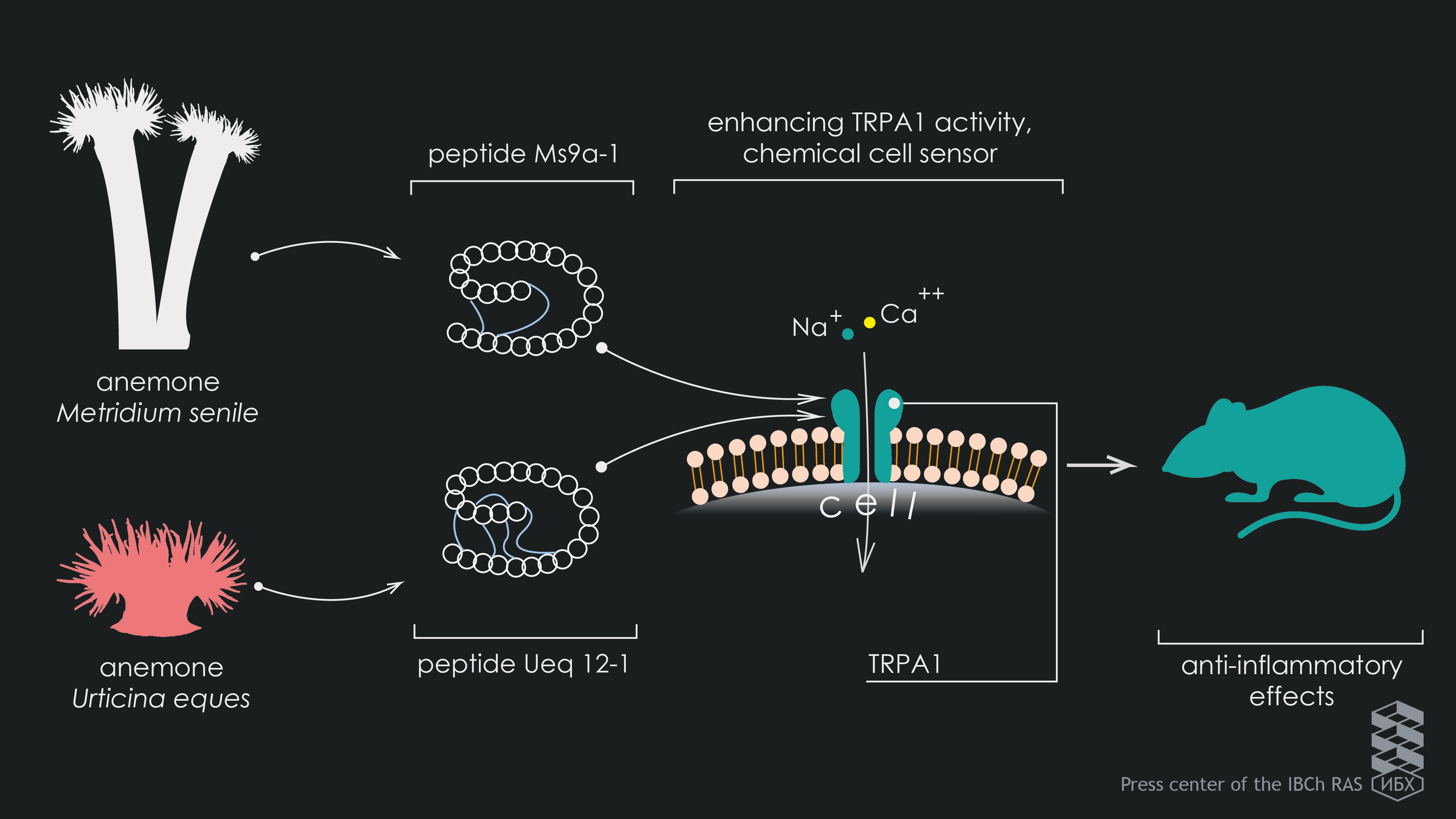Press-room / news / Science news /
Peptides from marine anemones gave analgesic effect
Researchers from the Institute of Bioorganic Chemistry RAS together with their colleagues have isolated the analgesic peptides Ms9a-1 and Ueq 12-1 from sea anemones, one of the most ancient predators on the planet. The ability of these substances to selectively enhance the activity of TRPA1 receptor opens up new opportunities for basic research and serves as a basis for the painkillers and anti-inflammatory drugs development. The research was supported by the Russian Science Foundation, and the results were published in the Journal of Biological Chemistry and Toxins.
Traditional medicine for centuries created its own drug prescriptions through experience. However, the question of a molecular mechanism of their action remained open for a long time. In due course scientists have found out substances which allow “folk drugs” to render effect at catarrhal diseases treatment. So, they figured out why the mustard irritates the skin, causing vasodilation and a rush of blood. It turned out that these effects are due to allyl isothiocyanate, a compound that gives the sharpness and characteristic smell of mustard, wasabi, horseradish and some other products.
“The TRPA1 receptor helps to recognize such chemicals,” explains Sergey Kozlov, D.Sc., head of the Laboratory of Neuroreceptors and Neuroregulators of the IBCh RAS, where most of the experiments were carried out. “The receptor is located on the membrane of many human and animal cells, is distributed in sensory neurons of the skin, intestinal epithelial cells, lungs and bladder. A correlation of this receptor gain-of-function activity with chronic itching and allergic dermatitis is known, as well as a connection with the “episodic pain syndrome”, a heritable disease that is characterized by unexpectedly debilitating pain triggered by fasting or physical stress. Therefore, scientists are looking for pharmacological agents that are able to selectively interact with this receptor in order to create more effective anti-inflammatory and analgesic drugs.”
In a new study, scientists from Shemyakin-Ovchinnikov Institute of Bioorganic Chemistry of the Russian Academy of Sciences (IBCh RAS), Branch of the Shemyakin-Ovchinnikov Institute in Pushchino (BIBCh), Sechenov First Moscow State Medical University, Norwegian College of Fishery Science, Pushchino State Institute of Natural Sciences and Moscow Institute of Physics and Technology investigating extracts of sea anemones (some of the most ancient predators on the planet) detected peptides (short proteins) capable enhancing TRPA1 activity. This study was carried out on cold water sea anemones Metridium senile and Urticina eques, living in the northern latitude of the World Ocean.

Author - Snezana Mazhekenova.
Despite the common biological target, the peptides are completely different from each other by structure. The first peptide, Ms9a-1, from the sea anemone Metridium senile is short (contains 35 amino acid residues) and have spatial structure stabilized by two disulfide bridges. The second one, longer peptide Ueq 12-1 (45 amino acid residues) has uncommon structural fold stabilized by five disulfide bridges and represents a new family of sea anemone peptides. According to researchers comments the structure determination for such close-packed and disulfide-linked molecule was not easy but interesting task that has been successfully solved in the cooperation with the Laboratory of Nuclear Magnetic Resonance Spectroscopy of the IBCh RAS.
Tests in vivo on mice showed that intravenous peptides injection gave a significant analgesic and anti-inflammatory effect. At the same time, the molecules did not cause any painful sensations or thermal hypersensitivity. The peptides analgesic and anti-inflammatory effects are due to the fact that interacting with TRPA1 peptides make the receptor more sensitive to recognition of allyl isothiocyanate, which is a specific TRPA1 activator. If exogenous TRPA1 agonists emerged, for example, mediators of inflammation, the sensitivity of neurons expressed TRPA1 is lost and followed pain sensation decrease.
“Despite a wide range of analgesic drugs that can be found in drugstore today, medicines combined efficiency and safety are not exist,” says Sergey Kozlov. “Some side effects have both opioid narcotic analgesics, and non-steroidal anti-inflammatory drugs. TRPA1 is one of the most promising biological target for painkillers development. Finding the way to control the TRPA1 activity via selective peptides application will be a huge step towards the targeted therapy for a number of diseases based on the inflammatory. Further complex peptides investigation on animals could clarify their practical potential as anti-inflammatory and analgesic drugs.”
may 22, 2017

